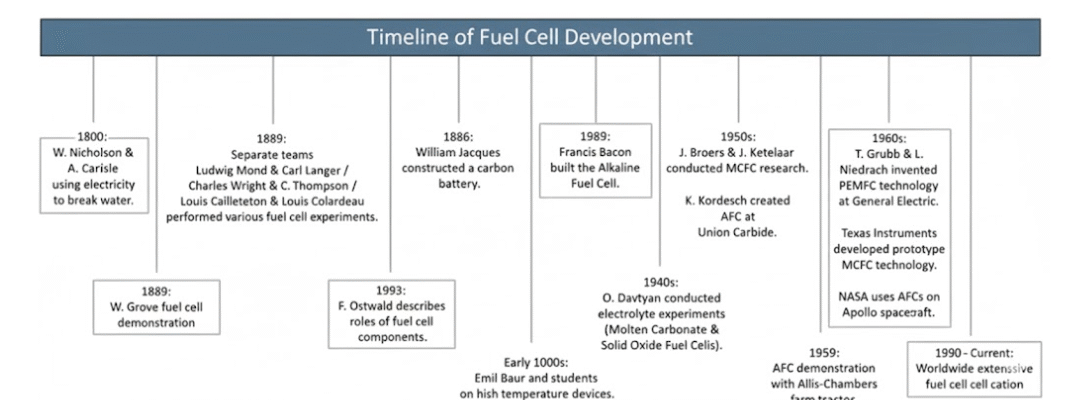1.1 History of Fuel Cell Technology
Fuel cells have fascinated scientists for over 150 years. Their origins can be traced back to 1800 when William Nicholson and Anthony Carlisle discovered how electricity could split water into hydrogen and oxygen. Building on this, Sir William Grove created the first rudimentary fuel cell in 1839—reversing the electrolysis process using a “gas battery” that recombined hydrogen and oxygen to produce electricity.
Ludwig Mond & Carl Langer (1889)
Developed one of the earliest practical hydrogen-oxygen fuel cells using coal gas, but faced issues with electrolyte evaporation and gas leakage.
Charles R. Alder Wright & C. Thompson (1890s)
Conducted experiments on hydrogen-oxygen cells but progress was limited due to technical difficulties and lack of financial support.
Friedrich Wilhelm Ostwald (1893)
Provided the fundamental electrochemical theory explaining how fuel cells operate, laying the foundation for modern fuel cell science.
Louis Paul Cailletet & Louis Joseph Colardeau (Late 1800s)
Criticized early fuel cell designs as impractical and too costly because they relied on expensive platinum catalysts.
William W. Jacques (1896)
Developed the “carbon battery,” claiming high efficiency, but practical tests showed only 8% efficiency—far below expectations.
Emil Baur & O.K. Davtyan (1930s)
Pioneered research on high-temperature fuel cells, contributing to the development of Solid Oxide Fuel Cells (SOFC) and Molten Carbonate Fuel Cells (MCFC).
1.2 Advantages of Fuel Cells
Fuel cells offer a wide range of benefits over traditional combustion engines and batteries:
1. Zero Emissions (on Pure Hydrogen)
When powered by pure hydrogen, fuel cells emit only water vapor and heat—resulting in clean, pollution-free energy.
2. Higher Efficiency
Unlike combustion engines that rely on thermal energy conversion, fuel cells use direct electrochemical reactions, bypassing Carnot efficiency limits.
3. Better Part-Load Performance
Fuel cells maintain high efficiency even when not operating at full capacity, unlike internal combustion engines which see sharp efficiency drops at partial loads.
4. Rapid Load Response
Fuel cells, especially those running on hydrogen, can quickly adjust to changing power demands.
5. Fewer Energy Conversions
For electric power output, fuel cells are more efficient due to minimal energy transformation stages.
6. Low Operating Temperatures
Some fuel cells, especially PEMFCs, operate below 100°C—allowing fast startup and fewer safety risks.
7. Cogeneration Opportunities
They produce both electricity and usable heat or hot water, boosting overall efficiency in combined heat and power (CHP) systems.
8. Minimal Maintenance
No tuning or recharging is required. Refueling hydrogen is faster than charging batteries and can deliver longer range.
1.3 Disadvantages of Fuel Cells
Despite their advantages, fuel cells also face significant limitations:
1. Hydrogen Supply Issues
- Producing and storing hydrogen is costly, energy-intensive, and often tied to fossil fuels.
2. Storage Challenges
- Gaseous hydrogen needs bulky tanks; liquid hydrogen requires cryogenic systems. Reforming hydrocarbons simplifies storage but reduces environmental benefits.
3. Fuel Purity Requirements
- Fuel cells are sensitive to contaminants like sulfur and carbon compounds that can destroy catalysts.
4. High Cost of Materials
- Most automotive fuel cells require platinum—an expensive and scarce catalyst material.
5. Freezing Issues
- Water inside the fuel cell must be removed or heated to prevent freezing and damage.
6. Membrane Humidity Needs
- Proton Exchange Membranes (PEMs) must stay moist to function properly and avoid damage.
7. Complex System Design
- Supporting systems like compressors and reformers add mechanical complexity and weight.
8. Heaviness
- Although lighter than batteries, complete fuel cell systems (including fuel tanks and reformers) are currently heavier than combustion engines.
9. Emerging Technology
- Fuel cells are still developing—cost, reliability, and widespread adoption are ongoing engineering challenges.

